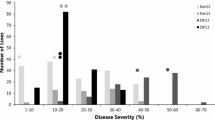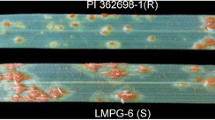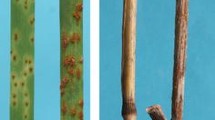Abstract
Key message
Adult plant stem rust resistance locus, QSrGH.cs-2AL, was identified in durum wheat Glossy Huguenot and mendelised as Sr63. Markers closely linked with Sr63 were developed.
Abstract
An F3 population from a Glossy Huguenot (GH)/Bansi cross used in a previous Australian study was advanced to F6 for molecular mapping of adult plant stem rust resistance. Maturity differences among F6 lines confounded assessments of stem rust response. GH was crossed with a stem rust susceptible F6 recombinant inbred line (RIL), GHB14 (M14), with similar maturity and an F6:7 population was developed through single seed descent method. F7 and F8 RILs were tested along with the parents at different locations. The F6 individual plants and both parents were genotyped using the 90 K single nucleotide polymorphism (SNP) wheat array. Stem rust resistance QTL on the long arms of chromosomes 1B (QSrGH.cs-1BL) and 2A (QSrGH.cs-2AL) were detected. QSrGH.cs-1BL and QSrGH.cs-2AL were both contributed by GH and explained 22% and 18% adult plant stem rust response variation, respectively, among GH/M14 RIL population. RILs carrying combinations of these QTL reduced more than 14% stem rust severity compared to those that possessed QSrGH.cs-1BL and QSrGH.cs-2AL individually. QSrGH.cs1BL was demonstrated to be the same as Sr58/Lr46/Yr29/Pm39 through marker genotyping. Lines lacking QSrGH.cs-1BL were used to Mendelise QSrGH.cs-2AL. Based on genomic locations of previously catalogued stem rust resistance genes and the QSrGH.cs-2AL map, it appeared to represent a new APR locus and was permanently named Sr63. SNP markers associated with Sr63 were converted to kompetetive allele-specific PCR (KASP) assays and were validated on a set of durum cultivars.





Similar content being viewed by others
Data availability
90 k SNP data is available on request.
Change history
17 November 2022
A Correction to this paper has been published: https://doi.org/10.1007/s00122-022-04240-7
References
Ayliffe M, Periyannan SK, Feechan A, Dry I, Schumann U, Wang M-B, Pryor A, Lagudah E (2013) A simple method for comparing fungal biomass in infected plant tissues. MPMI 26:658–667. https://doi.org/10.1094/MPMI-12-12-0291-R
Bansal U, Bariana H, Wong D, Randhawa M, Wicker T, Hayden M, Keller B (2014) Molecular mapping of an adult plant stem rust resistance gene Sr56 in winter wheat cultivar Arina. Theor Appl Genet 127:1441–1448. https://doi.org/10.1007/s00122-014-2311-1
Bariana HS, Hayden MJ, Ahmed NU, Bell JA, Sharp PJ, McIntosh RA (2001) Mapping of durable adult plant and seedling resistances to stripe rust and stem rust diseases in wheat. Aust J Agric Res 52:1247–1255. https://doi.org/10.1071/AR01040
Bassi FM, Sanchez-Garcia M (2017) Adaptations and stability analysis of ICARDA durum wheat (Triticum durum desf.) elites across 18 countries. Crop Sci 57:2419–2430. https://doi.org/10.2135/cropsci2016.11.0916
Bergh K, Chew A, Gugerty MK, Anderson CL (2012) Wheat value chain: Ethiopia. Evan school policy analysis research. (https://evans.uw.edu/policy-impact/epar/research/crop-value-chains-wheat-ethiopia)
Bhattacharya S (2017) Deadly new wheat disease threatens Europe’s crops. Nature 542:145–146. https://doi.org/10.1038/nature.2017.21424
Broman KW, Wu H, Sen S, Churchill GA (2003) R/qtl: QTL mapping in experimental crosses. Bioinformatics 19:889–890
Butler DG, Cullis BR, Gilmour AR, Gogel BJ (2009) ASReml-R reference manual. Department of primary industries and Fisheries, The State of Queensland, Brisbane
Chen S, Zhang W, Bolus S, Rouse MN, Dubcovsky J (2018) Identification and characterization of wheat stem rust resistance gene Sr21 effective against the Ug99 race group at high temperature. PLoS Genet 14(4):e1007287. https://doi.org/10.1371/journal.pgen.1007287
Cobo N, Wanjugi H, Lagudah E, Dubcovsky J (2019) A high-resolution map of wheat QYr.ucw-1BL, an adult plant stripe rust resistance locus in the same chromosomal region as Yr29. Plant Genome 12:180055. https://doi.org/10.3835/plantgenome2018.08.0055
Ellis JG, Lagudah ES, Spielmeyer W, Dodds PN (2014) The past, present and future of breeding rust resistant wheat. Front Plant Sci 5:641. https://doi.org/10.3389/fpls.2014.00641
Fedak G (2015) Alien introgressions from wild Triticum species, T. monococcum, T. urartu, T. turgidum, T. dicoccum, T. dicoccoides, T. carthlicum, T. araraticum, T. timopheevii, and T. miguschovae. In: Márta Molnár-Láng M, Ceoloni C, Doležel J (eds) Alien introgression in wheat- cytogenetics, molecular biology, and genomics. Springer, pp 191–209. https://doi.org/10.1007/978-3-319-23494-6_8
Gill BK, Klindworth DL, Rouse MN, Zhang J, Zhang Q, Sharma JS, Chu C, Long Y, Chao S, Olivera PD, Friesen TL, Zhong S, Jin Y, Faris JD, Fiedler JD, Elias EM, Liu S, Cai X, Xu SS (2021) Function and evolution of allelic variations of Sr13 conferring resistance to stem rust in tetraploid wheat (Triticum turgidum L.). Plant J 106:1674–1691. https://doi.org/10.1111/tpj.15263
Haile JK, Nachit MM, Hammer K, Badebo A, Roder MS (2012) QTL mapping of resistance to race Ug99 of Puccinia graminis f. sp. tritici in durum wheat (Triticum durum Desf.). Mol Breed 30:1479–1493. https://doi.org/10.1007/s11032-012-9734-7
Hare RA (1997) Characterization and inheritance of adult plant stem rust resistance in durum wheat. Crop Sci 37:1094–1098. https://doi.org/10.2135/cropsci1997.0011183X003700040010x
Herrera-Foessel SA, Singh RP, Lillemo M, Huerta-Espino J, Bhavani S, Singh S, Lan C, Calvo-Salazar V, Lagudah ES (2014) Lr67/Yr46 confers adult plant resistance to stem rust and powdery mildew in wheat. Theor Appl Genet 127:781–789. https://doi.org/10.1007/s00122-013-2256-9
Herrera-Foessel SA, Singh RP, Huerta-Espino J, Salazar VC, Lagudah ES (2011) First report of slow rusting gene Lr46 in durum wheat. In: Technical workshop in Borlaug global rust initiative, St. Paul, MN, p 191
Herrera-Foessel SA, Singh RP, Huerta-Espino J, Rosewarne GM, Periyannan SK, Viccars L, Calvo-Salazar V, Lan C, Lagudah ES (2012) Lr68: a new gene conferring slow rusting resistance to leaf rust in wheat. Theor Appl Genet 124:1475–1486. https://doi.org/10.1007/s00122-012-1802-1
Kandiah P, Chhetri M, Hayden M, Ayliffe M, Bariana H, Bansal U (2020) Mapping of adult plant leaf rust resistance in Aus27506 and validation of underlying loci by In-Planta fungal biomass accumulation. Agronomy 10:943. https://doi.org/10.3390/agronomy10070943
Kosambi DD (1943) The estimation of map distances from recombination values. Ann Eugen 12:172–175. https://doi.org/10.1111/j.1469-1809.1943.tb02321.x
Lagudah ES (2011) Molecular genetics of race non-specific rust resistance in wheat. Euphytica 179:81–91. https://doi.org/10.1007/s10681-010-0336-3
Lagudah ES, Appels R, McNeil D (1991) The Nor-D3 locus of Triticum tauschii: natural variation and linkage to chromosome- 5 markers. Genome 34:387–395
Letta T, Maccaferri M, Badebo A, Ammar K, Ricci A, Crossa J, Tuberosa R (2013) Searching for novel sources of field resistance to Ug99 and Ethiopian stem rust races in durum wheat via association mapping. Theor Appl Genet 126:1237–1256. https://doi.org/10.1007/s00122-013-2050-8
Li H, Bariana H, Singh D, Zhang L, Dillon S, Whan A, Bansal U, Ayliffe M (2020) A durum wheat adult plant stripe rust resistance QTL and its relationship with the bread wheat Yr80 locus. Theor Appl Genet 133:3049–3066. https://doi.org/10.1007/s00122-020-03654-5
Maccaferri M, Ricci A, Salvi S, Milner SG, Noli E, Martelli PL, Casadio R, Akhunov E, Scalabrin S, Vendramin V, Ammar K (2015) A high-density, SNP-based consensus map of tetraploid wheat as a bridge to integrate durum and bread wheat genomics and breeding. Plant Biotech J 13:648–663. https://doi.org/10.1111/pbi.12288
Mago R, Spielmeyer W, Lawrence GJ, Ellis JG, Pryor AJ (2004) Resistance genes for rye stem rust (SrR) and barley powdery mildew (Mla) are located in syntenic regions on short arm of chromosome 1. Genome 47:112–121
Manly KF, Cudmore RH Jr, Meer JM (2001) Map Manager QTX, cross-platform software for genetic mapping. Mamm Genome 12:930–932
McFadden ES (1930) A successful transfer of emmer characters to vulgare wheat. J Am Soc Agron 22:1020–1034
Megerssa SH, Sorrells ME, Ammar K, Acevedo M, Bergstrom GC, Olivera P, Brown-Guedira G, Ward B, Degete AG, Abeyo B (2021) Genome-wide association mapping of seedling and adult plant response to stem rust in a durum wheat panel. Plant Genome 14(2):e20105. https://doi.org/10.1002/tpg2.20105
Olivera P, Newcomb M, Szabo LJ, Rouse M, Johnson J, Gale S, Luster DG, Hodson D, Cox JA, Burgin L, Hort M, Gilligan CA, Patpour M, Justesen AF, Hovmøller MS, Woldeab G, Hailu E, Hundie B, Tadesse K, Pumphrey M, Singh RP, Jin Y (2015) Phenotypic and genotypic characterization of race TKTTF of Puccinia graminis f. sp. tritici that caused a wheat stem rust epidemic in southern Ethiopia in 2013–14. Phytopathology 105:917–928. https://doi.org/10.1094/PHYTO-11-14-0302-FI
Olivera PD, Jin Y, Rouse M, Badebo A, Fetch T Jr, Singh RP, Yahyaoui A (2012) Races of Puccinia graminis f. sp. tritici with combined virulence to Sr13 and Sr9e in a field stem rust screening nursery in Ethiopia. Plant Dis 96:623–628
Olivera Firpo PD, Newcomb M, Flath K, Sommerfeldt-Impe N, Szabo LJ, Carter M, Luster DG, Jin Y (2017) Characterization of Puccinia graminis f. sp. tritici isolates derived from an unusual wheat stem rust outbreak in Germany in 2013. Plant Pathol 66:1258–1266. https://doi.org/10.1111/ppa.12674
Pakeerathan K, Bariana H, Qureshi N, Wong D, Hayden M, Bansal U (2019) Identification of a new source of stripe rust resistance Yr82 in wheat. Theor Appl Genet 132:3169–3176. https://doi.org/10.1007/s00122-019-03416-y
Pretorius ZA, Singh RP, Wagoire WW, Payne TS (2000) Detection of virulence to wheat stem rust resistance gene Sr31 in Puccinia graminis. F. sp. tritici in Uganda. Plant Dis 84:203. https://doi.org/10.1094/PDIS.2000.84.2.203B
Pretorius ZA, Ayliffe M, Bowden RL, Boyd LA, Depauw RM, Jin Y, Knox RE, McIntosh RA, Park RF, Prins R, Lagudah ES (2017) Advances in control of wheat rusts. In: Langridge P (ed) Achieving sustainable cultivation of wheat, vol 1. Burleigh Dodds science publishing, Cambridge, pp 295–343. https://doi.org/10.19103/AS.2016.0004.20
Sall AT, Chiari T, Wasihun L, Kemal SA, Ortiz R, van Ginkel M, Bassi F (2019) Durum Wheat (Triticum durum Desf.): Origin, cultivation and potential expansion in sub-Saharan Africa. Agronomy 9:1–20. https://doi.org/10.3390/agronomy9050263
Singh RP (1991) Pathogenicity variations of Puccinia recondita f. sp. tritici and P. graminis f. sp. tritici in wheat-growing areas of Mexico during 1988 and 1989. Plant Dis 75:790–794
Singh RP, Hodson DP, Huerta-Espino J, Jin Y, Bhavani S, Njau P, Herrera-Foessel S, Singh PK, Singh S, Govindan V (2011) The emergence of Ug99 races of the stem rust fungus is a threat to world wheat production. Annu Rev Phytopathol 49:465–481. https://doi.org/10.1146/annurev-phyto-072910-095423
Singh RP, Hodson DP, Jin Y, Lagudah ES, Ayliffe MA, Bhavani S, Rouse MN, Pretorius ZA, Szabo LJ, Huerta-Espino J, Basnet BR, Lan C, Hovmøller MS (2015) Emergence and spread of new races of wheat stem rust fungus: continued threat to food security and prospects of genetic control. Phytopathology 105:872–884. https://doi.org/10.1094/PHYTO-01-15-0030-FI
Stakman EC, Stewart DM, Loegering WQ (1962) Identification of physiologic races of Puccinia graminis var. tritici. agricultural research service E617. United States department of agriculture, Washington DC
Taylor J, Butler D (2017) ASMap: linkage map construction using the MSTmap algorithm. R Package. https://doi.org/10.18637/jss.v079.i06
Toor AK, Bansal UK, Bhardwaj S, Badebo A, Bariana HS (2013) Characterization of stem rust resistance in old tetraploid wheat landraces from the Watkins collection. Genet Resour Crop Evol 60:1–9. https://doi.org/10.1007/s10722-013-9975-2
Valder G (1900) Macaroni wheats. Agric Gaz N S W 11:210–212
Verbyla AP, Cullis BR (2012) Multivariate whole genome average interval mapping: QTL analysis for multiple traits and/or environments. Theor Appl Genet 125:933–953. https://doi.org/10.1007/s00122-012-1884-9
Voorrips R (2002) MapChart: software for the graphical presentation of linkage maps and QTLs. J Hered 93:77–78
Wang S, Basten CJ, Zeng ZB (2012) Windows QTL cartographer 2.5, Department of statistics, North Carolina State University: Raleigh, NC
Wang S, Wong D, Forrest K, Allen A, Chao S, Huang BE, Maccaferri M, Salvi S, Milner SG, Cattivelli L, Mastrangelo AM, Whan A, Stephen S, Barker G, Wieseke R, Plieske J, Lillemo M, Mather D, Appels R, Dolferus R, Brown-Guedira G, Korol A, Akhunova AR, Feuillet C, Salse J, Morgante M, Pozniak C, Luo MC, Dvorak J, Morell M, Dubcovsky J, Ganal M, Tuberosa R, Lawley C, Mikoulitch I, Cavanagh C, Edwards KJ, Hayden M, Akhunov E (2014) Characterization of polyploid wheat genomic diversity using a high-density 90,000 single nucleotide polymorphism array. Plant Biotech J 12:787–796. https://doi.org/10.1111/pbi.12183
Wu Y, Bhat PR, Close TJ, Lonardi S (2008) Efficient and accurate construction of genetic linkage maps from the minimum spanning tree of a graph. PLoS Genet 4:e1000212. https://doi.org/10.1371/journal.pgen.1000212
Zhang W, Chen S, Abate Z, Nirmala J, Rouse MN, Dubcovsky J (2017) Identification and characterization of Sr13, a tetraploid wheat gene that confers resistance to the Ug99 stem rust race group. Proc Natl Acad Sci U S A 114:E9483–E9492. https://doi.org/10.1073/pnas.1706277114
Zhu T, Wang L, Rimbert H, Rodriguez JC, Deal KR, De Oliveira R, Choulet F, Keeble-Gagnère G, Tibbits J, Rogers J, Eversole K, Appels R, Gu YQ, Mascher M, Dvorak J, Luo M-C (2021) Optical maps refine the bread wheat Triticum aestivum cv. Chin Spring Genome Assem Plant J 107:303–314. https://doi.org/10.1111/tpj.15289
Acknowledgements
We thank Dr W. Spielmeyer for helpful suggestions and Dr R. Hare for providing GH/B F3 population. This project was supported by funds provided through Grains Research and Development Corporation, Australia (CSP00161).
Funding
This project was supported by funds provided through Grains Research and Development Corporation, Australia (CSP00161)
Author information
Authors and Affiliations
Contributions
HB and ES conceived and designed the study and initiated the crosses and phenotyping. RM generated the GHxM14 RILs. MR, J H-E, BB, and RPS did phenotyping. KF and MH did 90 k SNP genotyping. AW did the initial QTL analysis. XX and SC prepared DNA and XX and GP helped with KASP marker analysis. CC and UB performed QTL and statistical analysis and generated the maps. RM wrote the manuscript. All authors read and approved the manuscript.
Corresponding authors
Ethics declarations
Conflict of interest
The authors declare that they have no conflict of interest.
Additional information
Communicated by Lingrang Kong.
Publisher's Note
Springer Nature remains neutral with regard to jurisdictional claims in published maps and institutional affiliations.
Supplementary Information
Below is the link to the electronic supplementary material.
Rights and permissions
About this article
Cite this article
Mago, R., Chen, C., Xia, X. et al. Adult plant stem rust resistance in durum wheat Glossy Huguenot: mapping, marker development and validation. Theor Appl Genet 135, 1541–1550 (2022). https://doi.org/10.1007/s00122-022-04052-9
Received:
Accepted:
Published:
Issue Date:
DOI: https://doi.org/10.1007/s00122-022-04052-9




